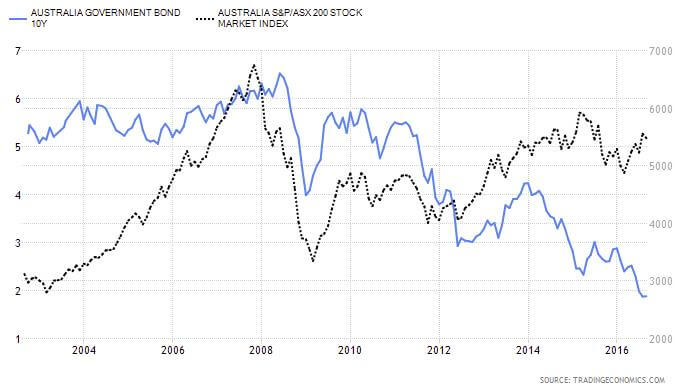Invest
The impact of low inflation on portfolios
With interest rates at historic lows, it’s prudent that investors understand the impact inflation has on their investment portfolios and superannuation balances.
The impact of low inflation on portfolios
With interest rates at historic lows, it’s prudent that investors understand the impact inflation has on their investment portfolios and superannuation balances.

On 2 August, the Reserve Bank announced a cut to official interest rates from 1.75 per cent to a historic low of 1.50 per cent in an effort to stimulate our slowing economy and avoid the slowdown many commentators have been anxiously predicting and is now playing out in the results currently being reported by some of our largest companies such as the big banks, Wesfarmers and Telstra.

While inflationary pressures are currently lacking domestically and globally, it is important for Australian investors to avoid becoming complacent about the effects a shift in the economic climate could have on asset prices.
A lower inflationary environment means lower interest rates and income streams

Australia, like other major economies, has experienced a sustained period of disinflation, a term generally used to describe a reduction in the inflation rate. This has led the RBA and other central banks to progressively lower the cash rate to record lows to encourage investment and stimulate the economy.
Ironically, debt markets are now pricing in the prospect of deflation (falling prices) which is far worse than inflation. As an example, investors are prepared to lend their money to the Swiss government for 50 years knowing full well that they will get back less than they started with. Global growth is slowing and many investors are more concerned about getting their capital back rather than getting a return on their capital.
Investors seeking higher returns than those offered by bonds and cash are being forced to take on greater levels of risk to maintain income streams as returns on ‘safer assets’ such as bank term deposits continue to dwindle. Up until now (notwithstanding the associated risks), the domestic economic backdrop has been supportive for shares offering attractive and largely sustainable dividends and property (provided one has a secure tenant).
What are central banks around the world doing to counter a deflationary environment. These statistics are worth considering:
• There has been 637 interest rate cuts globally since the start of the Global Financial Crisis.
• US$12.3 trillion in asset purchases have been made by central banks through global quantitative easing (money-printing) programs.
• There is US$15 trillion in government debt returning less than zero per cent.
• There are 489 million people living in countries with official interest rates of less than zero.
Ask yourself – surely all this activity will lead to inflation at some point?
There is a commonly-held belief that investors should never try and ‘fight central banks’. In other words, if central banks want to stimulate the economy and create inflation they will succeed, and conversely if they want to slow things down and choke off inflation, they can. They have unlimited firepower – no individual, company or government can beat them.
Portfolio considerations during inflationary periods
While inflationary pressures in Australia are lacking, it is important for investors to be wary in the event of a shift in the economic climate. This is because we have experienced a sustained period of low interest rates, both domestically and globally, and investors have built up ‘safe’ assets with ‘bond-like’ characteristics to very hefty levels in the pursuit of greater income. This could unwind quickly, causing capital losses for investors, in particular those late to the party.
Assuming you are a believer in the ‘don’t fight the central bank’ theory, when inflation finally emerges, central banks will respond by raising interest rates. Provided this is done in a slow and steady fashion (which is likely) there are some assets and asset classes that are naturally expected to perform better than others.
Shares in companies that are rapidly growing their earnings should outperform the shares of more mature businesses. Additionally, companies that can pass on higher prices to their customers can be well insulated. Companies that deliver consistent earnings will do far better than those with more volatile earnings.
Listed property trusts and direct property with leases that are linked to inflation and regular market rent reviews should hold up better than those that don’t.
Commodities like gold are often considered attractive investments due to the commonly held belief that the metal acts as a hedge against inflation because it has inherent value.
Floating rate bonds (where the interest rate payable is typically a margin over the RBA cash rate or bank bill swap rate) are considered to be more attractive than fixed rate bonds, provided that the underlying issuer is not placed under undue pressure as a result of rising costs of funding.
Not surprisingly, those who have borrowed at fixed rates can also benefit, as inflation tends to erode the liability of their debt over time. Borrowers would be wise to adjust variable rate debt to a fixed rate option if possible.
Cash and shorter dated term deposits would also be attractive. Longer-dated bank deposits would not.
In all cases, it would be wise to avoid holding investments in companies and securities with high debt levels as funding costs will rise, reducing profit margins. Reduced exposure to shares and property more broadly would be prudent as safer alternatives, such as bank deposits, become relatively more attractive.
Factors to ponder before investment markets deteriorate

No trend is permanent. While it might not seem likely right now, low inflation and interest rates and rising asset prices will not last forever. With this in mind, it is extremely important to employ an investment strategy that is appropriate for your risk profile, objectives and ability to tolerate market volatility.
It would be fair to say that the longer the current environment continues, the further out the risk curve investors will go to sustain their income and the greater the pain they will experience when interest rates and asset prices eventually normalise.
Before moving your funds out of government guaranteed bank deposits into long dated property developments offering eye-watering returns, it would be wise to give serious thought to the volatility in prices you are really prepared to accept.
Retirees will likely have far less tolerance than those younger and employed. Those with more capital can afford to ride out the cycle if a downturn emerges.
Portfolio diversification is one way to minimise investment risk by spreading your wealth across a variety of different asset classes (i.e. cash, bonds, domestic and international shares, and property). Managed funds and listed investment companies that are highly diversified provide very useful roles.
Timing and identifying high-quality businesses and assets are also critical factors in achieving appropriate investment returns and protecting your capital over the longer term.
Lastly, and most importantly, it would be prudent to ensure investment and superannuation portfolios are highly liquid to ensure there is the ability to reposition your assets and/or raise cash at short notice.
David Alder, director, Alder & Partners Private Wealth Management

Stock market
6K Additive secures A$48 million through initial public offering on the Australian Stock Exchange
6K Additive, a prominent player in the advanced metal powders and alloy additions market, has made a significant stride by successfully completing its Initial Public Offering (IPO) on the Australian ...Read more

Stock market
Institutional investors increase stock allocations to 18-year high amid cautious market shifts
In a recent development, State Street Markets unveiled the findings of its latest State Street Institutional Investor Indicators, revealing intriguing shifts in institutional investor behaviourRead more

Stock market
FOREX.com launches in Australia to empower self-directed traders
StoneX Group Inc. (NASDAQ: SNEX) has announced the Australian launch of FOREX.com, expanding access for self-directed traders to a global suite of Contracts for Difference (CFD) products across ...Read more

Stock market
Westpac and CMC Markets strengthen partnership to enhance online trading services
In a significant move that underscores the evolving landscape of online trading in Australia, CMC Markets Stockbroking has been chosen as the preferred vendor by Westpac Banking Corporation to extend ...Read more

Stock market
Portfolio reviews as an operating discipline: turning volatility into a competitive edge
In a higher-rate, higher-volatility world, portfolio reviews are no longer an annual hygiene task; they’re a core operating rhythm that protects cash flow, unlocks tax alpha, and sharpens risk ...Read more

Stock market
Fee war on the ASX: Global X’s A300 turns up the heat on core Aussie equity ETFs
Global X has lobbed a 0.04% management fee into Australia’s core equity sandbox, launching the Australia 300 ETF (A300) to take on entrenched giants. Read more

Stock market
Challenger IM shakes up the ASX with private credit note and a side of risk
Challenger Investment Management has taken private credit mainstream with an ASX-listed note structure—LiFTs—that secured roughly $100 million in cornerstone commitments within a day of launch. Read more

Stock market
International stocks: Diversifying your portfolio beyond Australia
In an increasingly globalized market, Australian investors have the opportunity to enhance their investment portfolio by incorporating international stocks. Diversifying your investments globally can ...Read more

Stock market
6K Additive secures A$48 million through initial public offering on the Australian Stock Exchange
6K Additive, a prominent player in the advanced metal powders and alloy additions market, has made a significant stride by successfully completing its Initial Public Offering (IPO) on the Australian ...Read more

Stock market
Institutional investors increase stock allocations to 18-year high amid cautious market shifts
In a recent development, State Street Markets unveiled the findings of its latest State Street Institutional Investor Indicators, revealing intriguing shifts in institutional investor behaviourRead more

Stock market
FOREX.com launches in Australia to empower self-directed traders
StoneX Group Inc. (NASDAQ: SNEX) has announced the Australian launch of FOREX.com, expanding access for self-directed traders to a global suite of Contracts for Difference (CFD) products across ...Read more

Stock market
Westpac and CMC Markets strengthen partnership to enhance online trading services
In a significant move that underscores the evolving landscape of online trading in Australia, CMC Markets Stockbroking has been chosen as the preferred vendor by Westpac Banking Corporation to extend ...Read more

Stock market
Portfolio reviews as an operating discipline: turning volatility into a competitive edge
In a higher-rate, higher-volatility world, portfolio reviews are no longer an annual hygiene task; they’re a core operating rhythm that protects cash flow, unlocks tax alpha, and sharpens risk ...Read more

Stock market
Fee war on the ASX: Global X’s A300 turns up the heat on core Aussie equity ETFs
Global X has lobbed a 0.04% management fee into Australia’s core equity sandbox, launching the Australia 300 ETF (A300) to take on entrenched giants. Read more

Stock market
Challenger IM shakes up the ASX with private credit note and a side of risk
Challenger Investment Management has taken private credit mainstream with an ASX-listed note structure—LiFTs—that secured roughly $100 million in cornerstone commitments within a day of launch. Read more

Stock market
International stocks: Diversifying your portfolio beyond Australia
In an increasingly globalized market, Australian investors have the opportunity to enhance their investment portfolio by incorporating international stocks. Diversifying your investments globally can ...Read more








